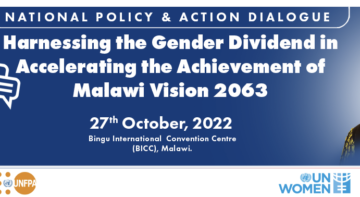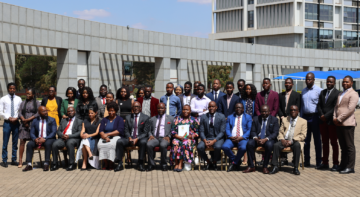Blogs

We have just concluded the implementation of the Strengthening Capacity to Use Research Evidence in Health Policy (SECURE Health) programme in the Ministry of Health (MoH) and Parliament in Kenya and Malawi (Nov 2013-Feb 2017). The programme sought to strengthen individual and institutional capacity for demand and use of evidence in decision-making. One of the objectives of the programme was to strengthen institutional capacity for enabling evidence use. The other objective was to strengthen individual capacity for increased demand and use of evidence.
We used Hodgson’s (2006, p.2) definition of institutions as « systems of established and prevalent social rules that structure social interactions. » In this sense, institutional capacity under the SECURE Health programme meant strengthening institutional policies and guidelines that promote and enable evidence use, strengthening leadership and action for tackling the many institutional barriers to evidence use (including lack of information resource centres, reliable Internet connectivity, and inadequate numbers of skilled technical staff to provide evidence to top level leaders), and increasing demand for evidence by top leaders.
We made some notable progress towards strengthening institutional capacity for evidence use even though we note that it was the most difficult objective to achieve and our results here are mixed. This is not surprising because strengthening institutions is complex and takes time « it is in fact the proverbial « elephant in the room’ when it comes to strengthening capacity for evidence use.
A major driver of the success that the programme realised generally, including against this objective on strengthening institutions, was as a result of the benefits that individuals accrued from participating in one or more of the programme’s interventions. Through the vignettes below, we share some of the roles that individuals embraced or the changes that individuals realised as a result of being part of the programme. We have deliberately anonymised these individuals because the purpose here is to illustrate the central role that these individuals played to enhance the impact of the programme, rather than praise them.
Mr X, a technical staff in one of the beneficiary institutions, only benefited from the programme’s evidence-informed policy-making (EIPM) training programme that aimed to strengthen technical knowledge and skills of individuals in evidence use (under objective two on strengthening individual capacity). This involved a 5-day training workshop, followed by a one-year mentorship programme. A few months after the 5-day training workshop, Mr X moved to a senior position in a different government agency where he is now championing evidence and promoting a culture of evidence use among his technical team. He has had his technical staff trained in EIPM and has committed to strengthening data gathering systems through his resource allocation systems to ensure that the decisions he makes or presents to the legislature are informed by good evidence.
Mr Y was the head of a research unit in one of the beneficiary institutions. He also benefited from the EIPM training programme and was involved in the planning and implementation of all other programme interventions. At the start, Mr Y had fairly limited appreciation of EIPM, but believed in the importance of research use in decision-making. He was also not very clear of the exact things that the research unit he was heading needed to do to support decision-making within the his institution. Understandably, he had just been recently posted to this unit, and had previously not been involved in EIPM forums, conferences or training workshops. Over the three years of programme implementation, Mr Y’s understanding of EIPM and the actions that his institution needs to undertake to enable increased evidence use greatly improved. This was clearly seen in the speeches he gave during programme activities (i.e. his narrative on evidence use); with time, his speeches became notably rich and insightful on what his institution needs to do to enable evidence use. For Mr Y, the change was seen largely in his increased understanding of what and how his unit needs to support the institution in enabling increased use of evidence and in entrenching an evidence use culture.
Ms D was a senior research official in her institution. The first time she heard about the SECURE Health programme and what it intended to do, she advised that the programme needed to target the leadership level because according to her that is where the problem was. « If you get top leaders committed to enabling or using evidence, then we will not struggle as technical staff in providing evidence, » said she. During programme implementation, Ms D was an important champion for the programme’s interventions, generating increased support for evidence from top leaders in her institution. At one point, she identified the need for the top leaders that she works with to understand and deliberate evidence on an issue that they were grappling with. She went ahead to work with the SECURE Health programme to organise an evidence dialogue for these leaders in order to help them make a better and evidence-informed decision on the issue. She has also been running an internal support initiative for her colleagues to improve the quality of evidence they provide for decision-making. This is an initiative that she has been championing as a result of interacting with the SECURE Health programme.
Mr H was a technical staff in his institution and benefited from the EIPM training programme. His unit generates a lot of reports on the issues they work and he is directly involved in this. At the workshop, he drew on some of these reports to develop a policy brief with clear policy recommendations on what his institution should do to address a specific issue. His brief has informed the development of a new strategy to address the issue in question.
Mr E was the head of a research unit in his institution. He had been involved in many evidence-to-policy (EIP) forums and was already known in his institution as a champion for evidence use even at the start of the SECURE Health programme. He repeatedly said that the SECURE Health programme was implementing the mandate of his unit. Because of this, he fully embraced the programme and led its implementation within his institution. He took every opportunity to engage top leaders and other actors in his country on the need for them to increase investments required to increase evidence use in decision-making. He extensively distributed the Guidelines for Evidence Use developed by the programme, and actively promoted the use of the Guidelines in different forums. For him, the programme was « God-sent’. He has committed to continue pushing his institution for increased funds for enabling evidence use as well as looking for funding from elsewhere to continue with some of the project interventions.
Mr J, a district officer of health, did not participate in any of the programme’s interventions. He, however, learned about the EIPM training programme from his colleagues who benefited from the programme and informed him about the skills they acquired on developing policy briefs. Given his interest in learning how to prepare policy briefs, Mr J went ahead to request us for guidance on how to prepare policy briefs. When he received the policy brief template and other reading materials, Mr J used these to develop a draft policy brief, which he sent to us for review and feedback. We reviewed and provided feedback on the brief, which he finalised.
For us, these experiences tell us that while institutions are important in enabling increased evidence use, the individuals working within these institutions are just as important. The individuals in these vignettes embraced the programme and went ahead to extend the impact of the programme’s interventions. Future efforts to strengthen capacity for evidence use need to focus as much on institutions as on individuals.
Related Posts





